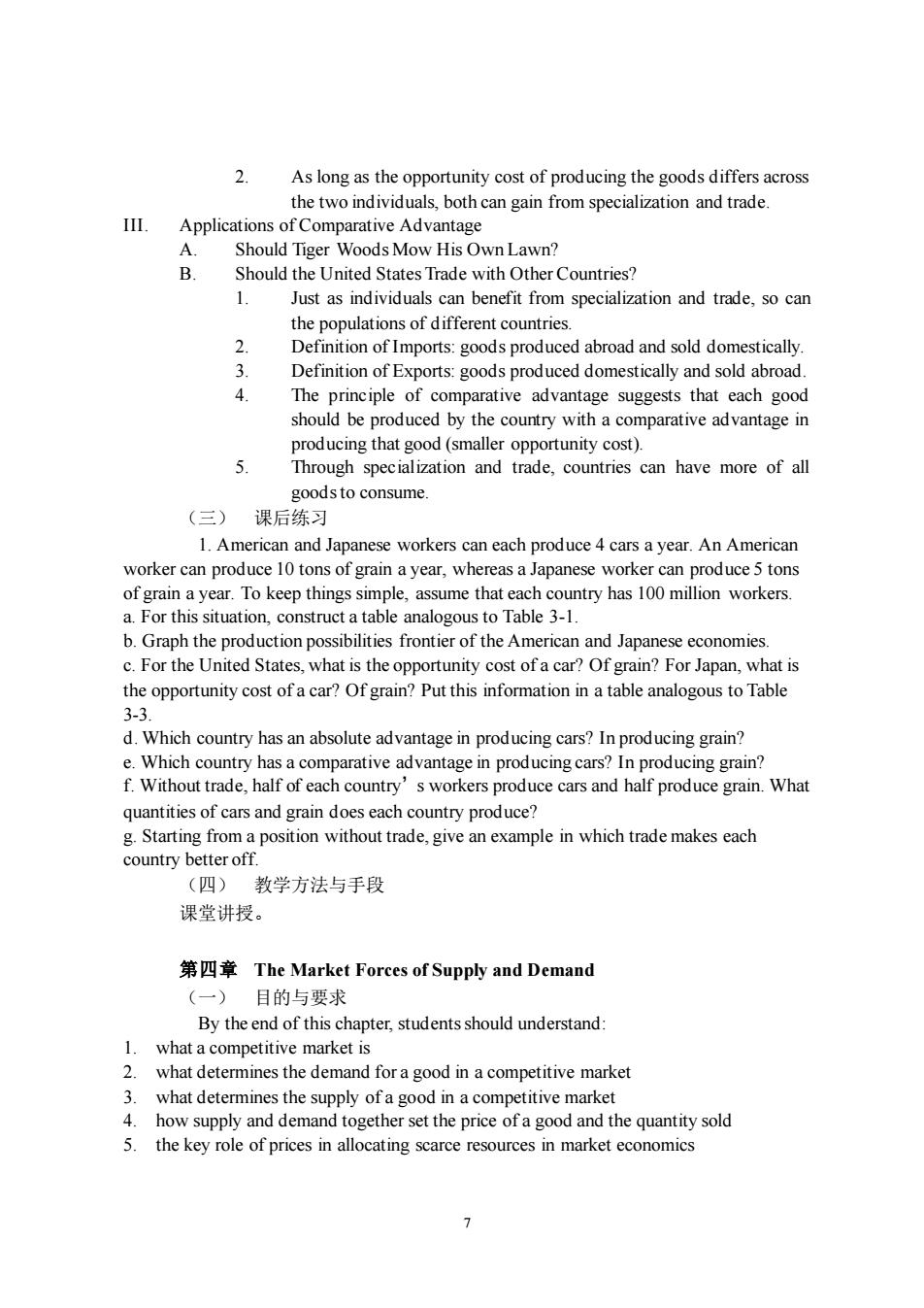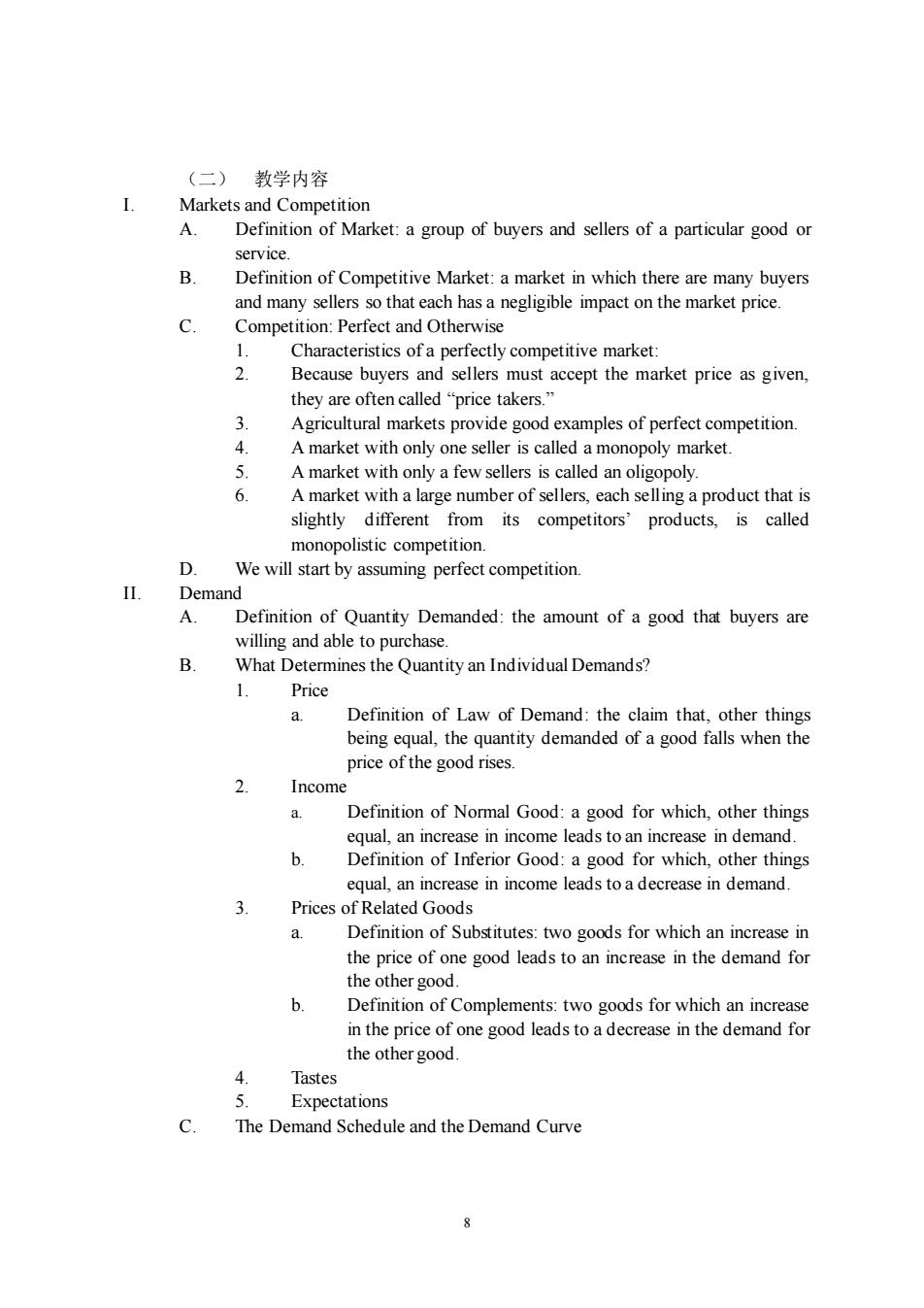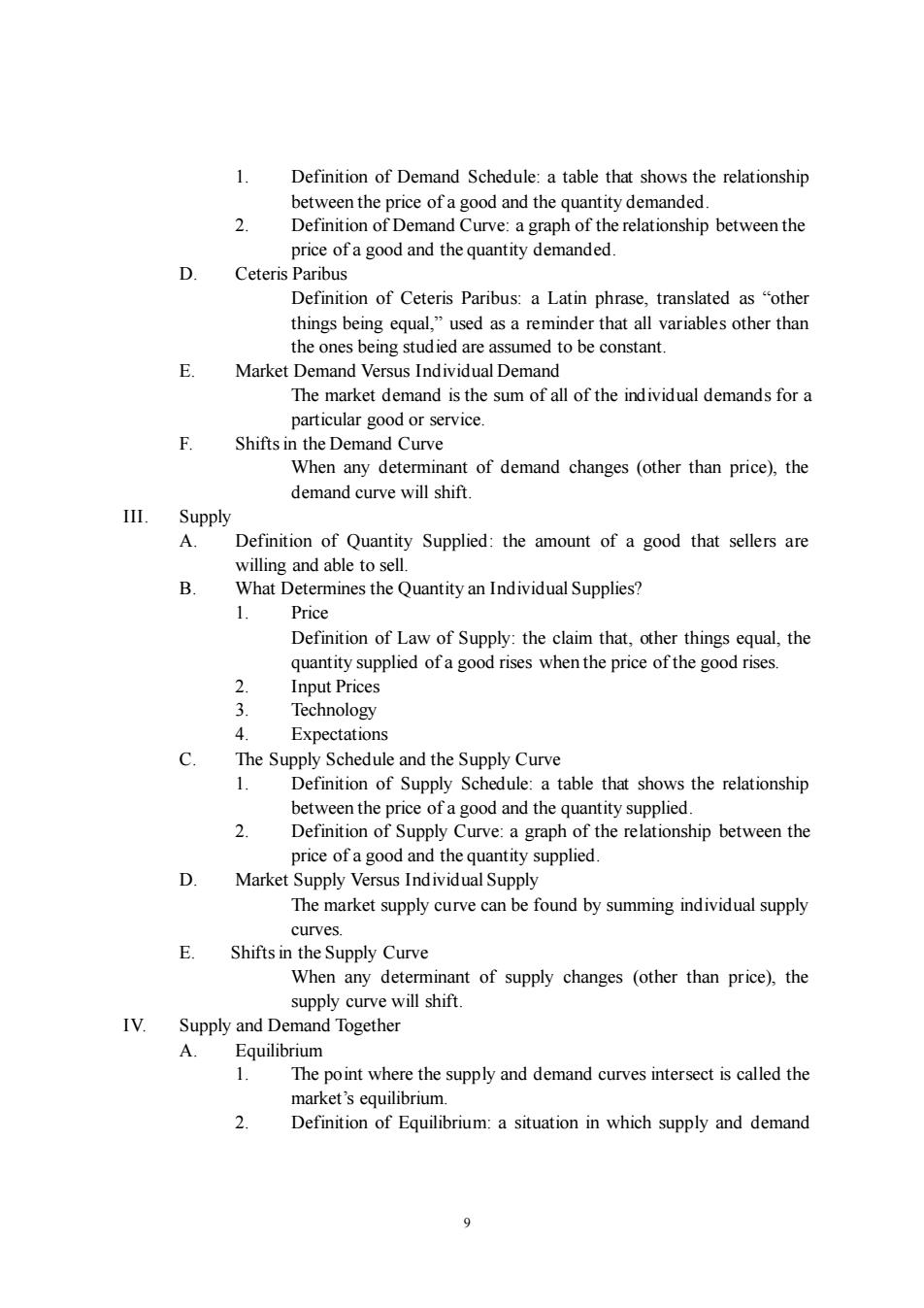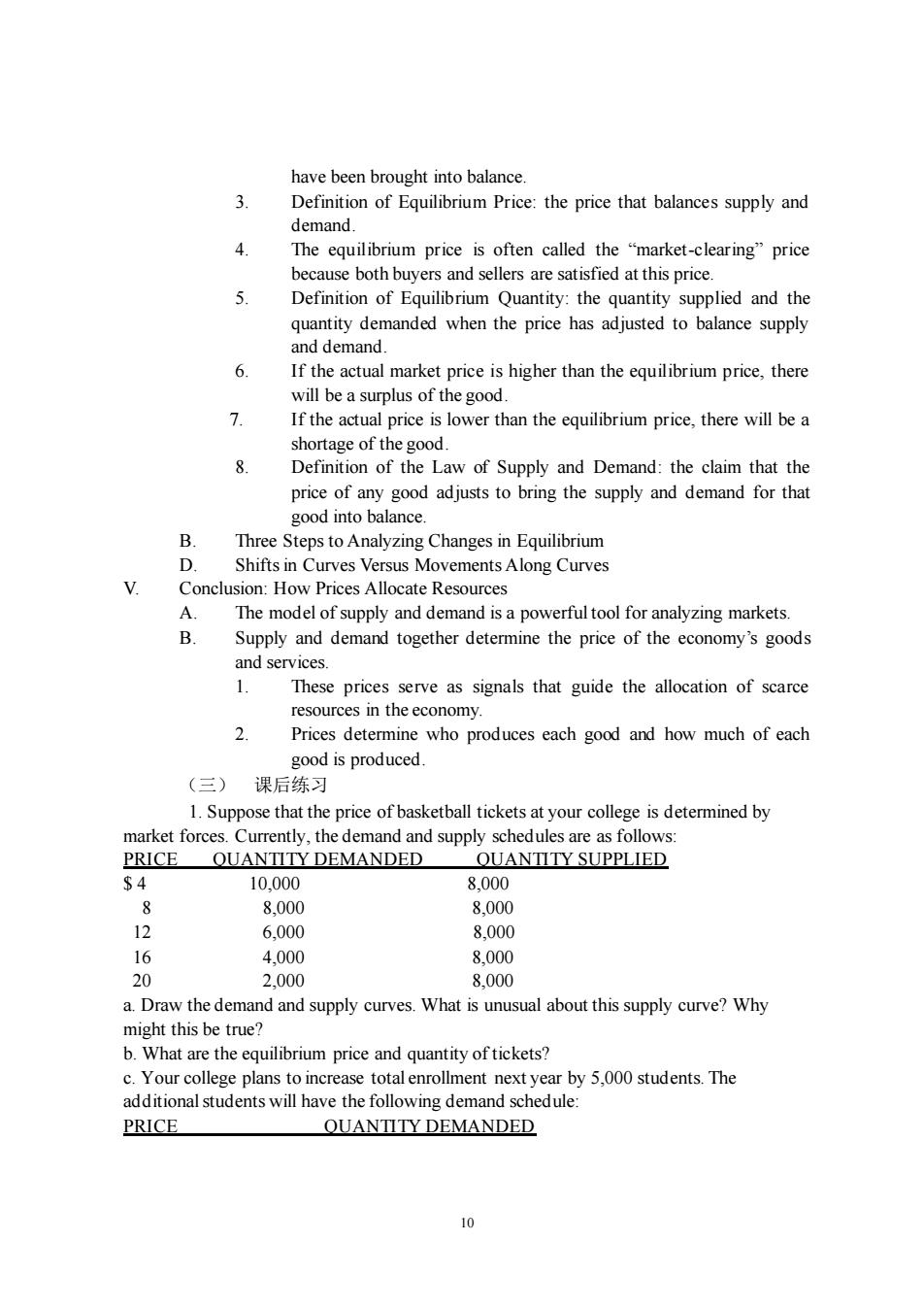
(三)课后练习 tradeoffs.Use a production possibilities frontier to illustrate society's tradeoff betweena clean environment and high incomes.What do you suppose determines the shape and position of the frontier?Show what happens to the frontier if engineers develop an automobile engine with almost no emissions (四) 教学方法与手段 课堂讲授。 第三章Interdependence and The Gains from Trade (-) 目的与要求 By the end of this chapter,students should understand: 1.how everyone can benefit when people trade with one another 2.the meaning of absolute advantage and comparative advantage 3.how compar ative advantage explains the gains from trade 4.how to apply the theory of comparative advantage to every life and nation policy. (二) 教学内容 A Parable for the Modem Economy A. Example:two goods meat and potatoes and two people a cattle rancher and a potato farmer (both of whom like to consume both potatoes and meat). Production possibilities The Principle of Comparative Advantage A. Absolute Advantage Definition of Absolute Advantage:the comparison among producers of a good according to their productivity. Opportunity Cost and Comparative Advantage Definition of Opportunity Co:whatever must be given up toobain some item. Definition of Comparative Advantage:the comparison among producers of a good according to their opportunity cost. 3. Because the opportunity cost of producing one good is the inverse of the oppo the other,it is in possible fo person to have a comparative advantage in the production of both goods. Comparative Advantage and Trade When specialization in a good occurs (assuming there is a comparative advantage),total output will grow 6
6 (三) 课后练习 1. The first principle of economics discussed in Chapter 1 is that people face tradeoffs. Use a production possibilities frontier to illustrate society’s tradeoff between a clean environment and high incomes. What do you suppose determines the shape and position of the frontier? Show what happens to the frontier if engineers develop an automobile engine with almost no emissions. (四) 教学方法与手段 课堂讲授。 第三章 Interdependence and The Gains from Trade (一) 目的与要求 By the end of this chapter, students should understand: 1. how everyone can benefit when people trade with one another 2. the meaning of absolute advantage and comparative advantage 3. how comparative advantage explains the gains from trade 4. how to apply the theory of comparative advantage to every life and nation policy. (二) 教学内容 I. A Parable for the Modern Economy A. Example: two goods — meat and potatoes and two people — a cattle rancher and a potato farmer (both of whom like to consume both potatoes and meat). B. Production Possibilities C. Specialization and Trade II. The Principle of Comparative Advantage A. Absolute Advantage Definition of Absolute Advantage: the comparison among producers of a good according to their productivity. B. Opportunity Cost and Comparative Advantage 1. Definition of Opportunity Cost: whatever must be given up to obtain some item. 2. Definition of Comparative Advantage: the comparison among producers of a good according to their opportunity cost. 3. Because the opportunity cost of producing one good is the inverse of the opportunity cost of producing the other, it is impossible for a person to have a comparative advantage in the production of both goods. C. Comparative Advantage and Trade 1. When specialization in a good occurs (assuming there is a comparative advantage), total output will grow

2 As long as the opportunity cost of producing the goods differs across the two individuals,both can gain from specialization and trade. III.Applications of Comparative Advantage Should Tiger Woods Mow His Own Lawn? ould the United States Trade with Other Countries? Just as individuals can benefit from specialization and trade.so can the populations of different countries. 2 Definition of Imports:goods produced abroad and sold domestically. Definition of Exports goods produced domestically and sold abroad 4 The ciple of comparative advantage suggests that each good should be produced by the country with a comparative advantage in producing that good(smaller opportunity cost). Through specialization and trade,countries can have more of all oods to consume (三)课后练习 1.American and Japanese workers can each produce 4 cars a year.An American worker can produce 10 tons of grain a year,whereas a Japanese worker can produce 5 tons of grainayear.To keep thingssi ssume that eachc ountry has 100 million workers For this tuatio s to Table 3-1. b.Graph the production possibilities frontier of the American and Japanese economies c.For the United States,what is the opportunity cost ofa car?Of grain?For Japan,what is the opportunity cost of a car?Of grain?Put this information in a table analogous to Table 23 d.Which counry has an absolute advantage in producing cars?In producir ng grain? country h a comparative advantage in prod acing cars?In roducing grain? f.Without trade,half of each country's workers produce cars and half produce grain.What quantities of cars and grain does each country produce? g.Starting from a position without trade,give an example in which trade makes each ntry better off. (四) 教学方法与手段 课堂讲授。 第四章The Market Forces of Suppl y and Demand 目的与要求 By the end of this chapter.students should understand 1. what a competitive market is 2.what determines the demand for a good in a competitive market 3. what determines the supply of a good in a competitive market 4.how supply and demand together set the price of a good and the quantity sold 5.the key role of prices in allocating scarce resources in market economics 7
7 2. As long as the opportunity cost of producing the goods differs across the two individuals, both can gain from specialization and trade. III. Applications of Comparative Advantage A. Should Tiger Woods Mow His Own Lawn? B. Should the United States Trade with Other Countries? 1. Just as individuals can benefit from specialization and trade, so can the populations of different countries. 2. Definition of Imports: goods produced abroad and sold domestically. 3. Definition of Exports: goods produced domestically and sold abroad. 4. The principle of comparative advantage suggests that each good should be produced by the country with a comparative advantage in producing that good (smaller opportunity cost). 5. Through specialization and trade, countries can have more of all goods to consume. (三) 课后练习 1. American and Japanese workers can each produce 4 cars a year. An American worker can produce 10 tons of grain a year, whereas a Japanese worker can produce 5 tons of grain a year. To keep things simple, assume that each country has 100 million workers. a. For this situation, construct a table analogous to Table 3-1. b. Graph the production possibilities frontier of the American and Japanese economies. c. For the United States, what is the opportunity cost of a car? Of grain? For Japan, what is the opportunity cost of a car? Of grain? Put this information in a table analogous to Table 3-3. d. Which country has an absolute advantage in producing cars? In producing grain? e. Which country has a comparative advantage in producing cars? In producing grain? f. Without trade, half of each country’s workers produce cars and half produce grain. What quantities of cars and grain does each country produce? g. Starting from a position without trade, give an example in which trade makes each country better off. (四) 教学方法与手段 课堂讲授。 第四章 The Market Forces of Supply and Demand (一) 目的与要求 By the end of this chapter, students should understand: 1. what a competitive market is 2. what determines the demand for a good in a competitive market 3. what determines the supply of a good in a competitive market 4. how supply and demand together set the price of a good and the quantity sold 5. the key role of prices in allocating scarce resources in market economics

(二)教学内容 Markets and Competition A. Definition of Market:a group of buyers and sellers of a particular good or service. B Definition of Competitive Market:a market in which there are many buyers and many sellers so that each has a negligible impact on the market price. Com etition:Perfect and Otherwise Charac eristics ofa perfectly competitive market Because buyers and sellers must accept the market price as given. they are often called"price takers." Agricultural markets provide good examples of perfect competition. A market with only one seller is called a poly market A market v re number of sellers.each selling proucth nly a few sellers i 6 ket w slightly different from its competitors'products,is called monopolistic competition. We will start by assuming perfect competition. II. A Definition of Quantity Demanded:the amount of a good that buyers are willing and able to purchase. B. What Determines the Quantity an Individual Demands? Price Definition of Law of Demand:the claim that,other thing being equal,the quantity demanded of a good falls when the price of the good rises. Income Definition of Normal Good:a good for which.other things equal,an increase in inco ase in demand b. Definitio 1ofInfierno ngs equal,an increase in income leads toa decrease in demand Prices of Related Goods a Definition of substitutes:two goods for which an increase in the price of one good leads to an increase in the demand for the othe b Definition of Complements:two goods for which an increase in the price of one good leads to a decrease in the demand for the other good. 4 Tastes Expectations C The Demand Schedule and the Demand Curve 8
8 (二) 教学内容 I. Markets and Competition A. Definition of Market: a group of buyers and sellers of a particular good or service. B. Definition of Competitive Market: a market in which there are many buyers and many sellers so that each has a negligible impact on the market price. C. Competition: Perfect and Otherwise 1. Characteristics of a perfectly competitive market: 2. Because buyers and sellers must accept the market price as given, they are often called “price takers.” 3. Agricultural markets provide good examples of perfect competition. 4. A market with only one seller is called a monopoly market. 5. A market with only a few sellers is called an oligopoly. 6. A market with a large number of sellers, each selling a product that is slightly different from its competitors’ products, is called monopolistic competition. D. We will start by assuming perfect competition. II. Demand A. Definition of Quantity Demanded: the amount of a good that buyers are willing and able to purchase. B. What Determines the Quantity an Individual Demands? 1. Price a. Definition of Law of Demand: the claim that, other things being equal, the quantity demanded of a good falls when the price of the good rises. 2. Income a. Definition of Normal Good: a good for which, other things equal, an increase in income leads to an increase in demand. b. Definition of Inferior Good: a good for which, other things equal, an increase in income leads to a decrease in demand. 3. Prices of Related Goods a. Definition of Substitutes: two goods for which an increase in the price of one good leads to an increase in the demand for the other good. b. Definition of Complements: two goods for which an increase in the price of one good leads to a decrease in the demand for the other good. 4. Tastes 5. Expectations C. The Demand Schedule and the Demand Curve

Definition of Demand Schedule:a table that shows the relationship between the price of a good and the quantity demanded. 2. Definition of Demand Curve:a graph of the relationship between the nanded D Ceteris Paribus Definition of Ceteris Paribus:a Latin phrase,translated as"other things being equal,"used as a reminder that all variables other than the ones being studied are assumed to be constant. Market Demand Versus Individual Demand The arket demand is the sum of all of the individual demands for a particular good or service Shifts in the Demand Curve When any determinant of demand changes (other than price),the demand curve will shift. Supply A. Definition of Quantity Supplied:the amount of a good that sellers are willing and able to sell. B. What Determines the Quantity an Individual Supplies? 1. Price Definition of Law of Supply:the claim that,other things equal,the quantity supplied ofa good rises when the price of the good rises Input Prices Technology 4 Expectations The Supply Schedule and the Sup oly Curv 1 of Supply Schedule a table that shows the relationship between the price of a good and the quantity supplied Definition of Supply Curve:a graph of the relationship between the price of a good and the quantity supplied D Market Supply Versus Individual Supply The market supply curve can found by summing individual supply curves Shifts in the Supply Curve When any determinant of supply changes (other than price).the supply curve will shift. IV Supply and Demand Together Equilibrium The point where the supply and demand curves intersect is called the market's equilibrium. Definition of Equilibrium:a situation in which supply and demand 9
9 1. Definition of Demand Schedule: a table that shows the relationship between the price of a good and the quantity demanded. 2. Definition of Demand Curve: a graph of the relationship between the price of a good and the quantity demanded. D. Ceteris Paribus Definition of Ceteris Paribus: a Latin phrase, translated as “other things being equal,” used as a reminder that all variables other than the ones being studied are assumed to be constant. E. Market Demand Versus Individual Demand The market demand is the sum of all of the individual demands for a particular good or service. F. Shifts in the Demand Curve When any determinant of demand changes (other than price), the demand curve will shift. III. Supply A. Definition of Quantity Supplied: the amount of a good that sellers are willing and able to sell. B. What Determines the Quantity an Individual Supplies? 1. Price Definition of Law of Supply: the claim that, other things equal, the quantity supplied of a good rises when the price of the good rises. 2. Input Prices 3. Technology 4. Expectations C. The Supply Schedule and the Supply Curve 1. Definition of Supply Schedule: a table that shows the relationship between the price of a good and the quantity supplied. 2. Definition of Supply Curve: a graph of the relationship between the price of a good and the quantity supplied. D. Market Supply Versus Individual Supply The market supply curve can be found by summing individual supply curves. E. Shifts in the Supply Curve When any determinant of supply changes (other than price), the supply curve will shift. IV. Supply and Demand Together A. Equilibrium 1. The point where the supply and demand curves intersect is called the market’s equilibrium. 2. Definition of Equilibrium: a situation in which supply and demand

have been brought into balance. Definition of Equilibrium Price:the price that balances supply and demand 4 The equilibrium price is often called the "market-clearing"price because both buyers and sellers are satisfied at this price. Definition of Equilibrium Quantity:the quantity supplied and the quantity demanded when the price has adjusted to balance supply and demand. 6. If the actual market price is higher than the equilibrium price.there will be a surplus of the goo 1 If the actual price is lower than the equilibrium price,there will be a shortage of the good. 8 Definition of the Law of Supply and Demand:the claim that the price of any good adjusts to bring the supply and demand for that good into bala B Three Steps to Analyzing Changes in Equilibrium D. Shifts in Curves Versus Movements Along Curves V Conclusion:How Prices Allocate Resources A The model of supply and demand is a powerful tool for analyzing markets. Supply and demand together determine the price of the economy's good and services 1. These prices serve as signals that guide the allocation of scarce resources in the economy. Prices determine who produces each good and how much of each god isproduced. (三) 课后练习 1.Suppose that the price of basketball tickets at your college is determined by market forces PRICE QUaNTITY DEMANDED QUANTITY SUPPLIED 4 10.,000 8,000 8.000 8.000 12 6.000 8.000 6 4.000 8000 20 2.000 8,000 a.Draw the demand and supply curves.What is unusual about this supply curve?Why might this be true? b.What are the equilibrium price and quantity of tickets? c.Your college plans to increase total enrollment next vear by 5.000 students.The additional students will have the following demand schedule PRICE QUANTITY DEMANDED 10
10 have been brought into balance. 3. Definition of Equilibrium Price: the price that balances supply and demand. 4. The equilibrium price is often called the “market-clearing” price because both buyers and sellers are satisfied at this price. 5. Definition of Equilibrium Quantity: the quantity supplied and the quantity demanded when the price has adjusted to balance supply and demand. 6. If the actual market price is higher than the equilibrium price, there will be a surplus of the good. 7. If the actual price is lower than the equilibrium price, there will be a shortage of the good. 8. Definition of the Law of Supply and Demand: the claim that the price of any good adjusts to bring the supply and demand for that good into balance. B. Three Steps to Analyzing Changes in Equilibrium D. Shifts in Curves Versus Movements Along Curves V. Conclusion: How Prices Allocate Resources A. The model of supply and demand is a powerful tool for analyzing markets. B. Supply and demand together determine the price of the economy’s goods and services. 1. These prices serve as signals that guide the allocation of scarce resources in the economy. 2. Prices determine who produces each good and how much of each good is produced. (三) 课后练习 1. Suppose that the price of basketball tickets at your college is determined by market forces. Currently, the demand and supply schedules are as follows: PRICE QUANTITY DEMANDED QUANTITY SUPPLIED $ 4 10,000 8,000 8 8,000 8,000 12 6,000 8,000 16 4,000 8,000 20 2,000 8,000 a. Draw the demand and supply curves. What is unusual about this supply curve? Why might this be true? b. What are the equilibrium price and quantity of tickets? c. Your college plans to increase total enrollment next year by 5,000 students. The additional students will have the following demand schedule: PRICE QUANTITY DEMANDED